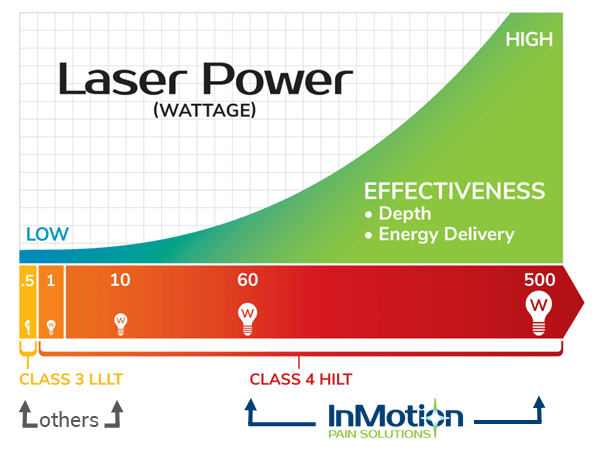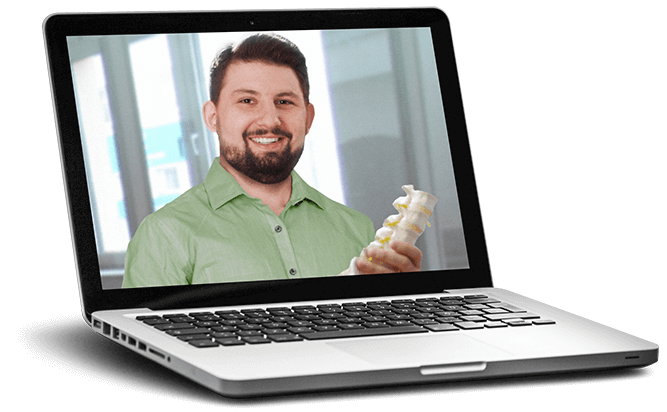5 Things to Know About Laser Therapy

At InMotion Pain Solutions in Cedar Rapids, High Intensity Laser Therapy (HILT), also known as photobiomodulation therapy, is the cornerstone of our treatment for chronic pain. We combine FDA-cleared, non-invasive, drug-free laser therapy with other therapies to relive pain and restore motion for long-lasting pain relief.
Many of our patients hadn’t heard of laser therapy before coming to InMotion Pain Solutions’ laser pain center. That’s too bad, because there are so many advantages to using HILT. We put together a list of 5 important things that we think everyone should know about High Intensity Laser Therapy.
1. Laser Therapy Provides Lasting Pain Relief Without Dangerous Side Effects
When administered by properly trained professionals, there are no known side effects of high intensity laser therapy. HILT is an FDA-cleared, drug-free, non-invasive therapy that relieves pain by delivering healing light energy to the cells of your body.
This light energy causes photochemical changes within your body, also known as photobiomodulation (PBM). PBM from laser therapy:
- Relieves pain
- Speeds tissue healing and repair
- Softens scar tissue
- Calms muscle spasm
- Improves blood flow
- Reduces inflammation
- Improves nerve function
- Resets the chronic pain cycle
This is very different from the many risks and complications caused by traditional pain therapies.
Pain medications come with the risk of dependency, addiction, overdose, drug interactions, liver damage, and increased risk of heart disease and stroke. Side effects of pain medications can include the inability to concentrate, drowsiness, impaired judgment, nausea, constipation, and upset stomach.
Pain injections include epidural steroid injections, cortisone injections, nerve root blocks and joint blocks. These injections for pain carry the risk of infection, nerve damage, bleeding, allergic reactions, paralysis, cartilage breakdown, and inflammation. Some potential side effects of pain injections include decreased immunity, high blood sugar, stomach ulcers, arthritis, cataracts, and increased appetite.
Some patients seek surgical options for pain including back surgery, fusion surgery, knee replacement surgery, hip replacement surgery, and other joint replacement surgeries. Surgery, however, carries its own set of risks and side effects. Risks from surgery include infection, bleeding, nerve damage, paralysis, complications from anesthesia, blood clots, heart attack, stroke, problems with wound healing, and uncertain outcomes – including lingering post-surgical pain. Some of the side effects of surgery may include loss of stability in the joint or spine, restricted range of motion, replacement device failure, and increased scar tissue.
LEARN MORE: 8 Things to Consider Before Joint Replacement Surgery.
High intensity laser therapy offers pain relief without the risks and side effects of drugs, injections, and surgery. When combined with the other therapies at InMotion Pain Solutions, HILT can relieve pain and restore motion for lasting pain relief.
2. Laser Therapy Treats Acute and Chronic Pain Conditions in the Back, Hips, Knees, Neck, and More
HILT reduces pain and promotes healing in damaged tissues. This can help relieve both acute and chronic pain. One of the benefits of High Intensity Laser Therapy is reducing inflammation. This can be especially important when treating acute (or new) injuries. The sooner inflammation is reduced, the sooner healing can begin. Faster tissue repair and healing of acute injuries will help you return to normal activities sooner.
Laser therapy is also effective at treating chronic pain. Two of the most important benefits of laser therapy for treating chronic pain is the softening of scar tissue and resetting the chronic pain cycle. Scar tissue is painful and can prevent proper movement. Laser therapy can loosen up scar tissue to help you get moving again.
LEARN MORE: Effective Treatment for Scar Tissue Pain
HILT also resets the chronic pain cycle. Over time, pain signals can actually become memorized in your interneurons. Laser light can penetrate into the cells of your body to reset the pain memory and restore proper communication between your brain and the rest of your body.
Laser therapy can treat most any neuromusculoskeletal pain condition, including:
- Arthritis, Osteoarthritis (head to toe)
- Back pain
- Head & neck pain
- Scar tissue pain
- Disk degeneration, disk herniation
- Sciatica, stenosis
- Shoulders, rotator cuffs, frozen shoulder
- ACL, MCL, TCL, Meniscus tears
- Joints: Knee pain, hip pain
- Foot Pain
- Post-surgical pain
3. Laser Treatment for Pain Requires Little to No Downtime
Because High Intensity Laser Therapy is non-invasive, you can continue to live your life while undergoing treatment. In fact, pain relief from laser therapy can make it easier to perform your daily activities. Increased range of motion, softened scar tissue, reduced inflammation, fewer muscle spasms, and increased blood flow all help to keep your life on track during treatment.
Joint replacement and other surgeries can require hospital stays and weeks to months of recovery time. Even pain injections can require a day or two off of work. The side effects of some pain medications can also take you away from living your life.
Laser therapy treatments are a part of an outpatient appointment at InMotion Pain Solutions in Cedar Rapids. It will take multiple treatments over time, but HILT will not limit your otherwise normal daily activities.
4. Healing Laser Therapy has Been In Use for Fifty Years
Endre Mester, M.D., D.S.c. first began studying the use of low-level lasers in medicine in the 1960s. Dr. Mester was conducting an experiment in which he placed malignant tumors below the skin surface in lab rats. He wanted to see if he could destroy the tumor using the light from the laser. What he found was shocking. The laser did not destroy the tumor. Instead, he found that the skin incisions (used to implant the tumor cells) treated with the laser, healed faster than those without laser treatment.
Dr. Mester has been called the “Grandfather of Laser Therapy” for discovering that low level laser therapy stimulated bodily tissues.
While it is commonly known as laser therapy, the scientific community prefers the term photobiomodulation.
LEARN MORE: The Science Behind Laser Therapy.
Over the past fifty years, much has been learned about the healing properties of laser therapy. The technology has become more powerful. Applications for laser therapy have increased. It has been used in Europe since the 1970s to treat musculoskeletal conditions. In 2002, laser therapy received FDA clearance in the U.S.
The healing technology of laser therapy is not new. It has been well studied for more than five decades.
Compare Pain Treatments
Medications? Injections? Surgery? InMotion Treatment? Which is the best choice for you? Get our side-by-side comparison and decide for yourself.
5. High Intensity Laser Therapy Outperforms vs. Low Level Laser Therapy
To effectively treat chronic pain and injuries, the healing laser light has to penetrate deep enough below the surface of the skin to reach the damaged tissue. This has led to the study and better understanding of the proper wavelengths and power necessary to be effective.
The FDA classifies therapeutic lasers on a scale of 1-4. The higher the classification, the more average power the laser delivers and the greater the risk of injury to the human eye. Class 1 – 3 lasers are considered Low Level Lasers, or Cold Lasers. Class 4 lasers are deemed High Intensity Lasers. Any laser with more than a half watt of power is considered a Class 4 laser, so even among High Intensity lasers, there exists a wide range of power.
It’s important to know that higher power does not, in and of itself, translate directly to improved clinical performance.
There are many factors that determine the effectiveness of a therapeutic laser. These factors are a combination of delivery of light energy measured in joules, photon density, continuous versus pulsating light delivery, laser wavelength, and realistic treatment times. It all boils down to delivering the right amount of light energy to the injured area in order for it to work.
Some early studies deemed laser therapy to be ineffective. We now know that had more to do with the power of the lasers used in the study, than the efficacy of laser therapy itself. Low-powered lasers can be effective at treating shallow injuries. However, deeper injuries, injuries encompassing a larger area, and chronic pain conditions require more power.
LEARN MORE: High Intensity Laser Therapy vs. Low Level Laser Therapy
InMotion Pain Solutions has some of the most powerful high intensity lasers available on the market today. The doctor will choose the appropriate laser and settings to customize a treatment plan based on your condition.

WATCH OUR
Free Online Webinar
- Understand Why Your Are in Pain
- Learn Why Other Treatments Haven’t Worked
- Discover a New Approach to Pain Relief
No-Cost Consultations and Second Opinions
If you would like to learn if High Intensity Laser Therapy could help treat your pain, we invite you to InMotion Pain Solutions in Cedar Rapids for a no-cost, no-obligation consultation or second opinion with Dr. Ben Wyant, D.C. During the consultation, we will learn more about your condition, answer your questions, and together, determine in our conservative pain solution may benefit you. And, if we don’t think that we can help you, we’ll tell you that too. Call InMotion Pain Solutions at 319-200-1495 or request a no-cost consult online.



